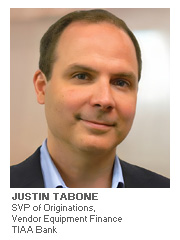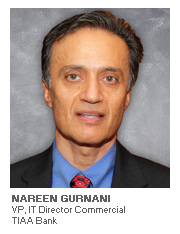
The highly competitive vendor equipment finance environment has made it more difficult than ever to not only win new business from prospects, but also retain long term relationship with vendor partners. Speed, efficiency, accuracy and creativity are hallmarks of a successful vendor program and as a result, finding ways to improve processes is paramount in order to provide what is ultimately the goal of any vendor program – to facilitate more equipment sales for the vendor and meet the end-user’s needs for equipment financing options.
Digital Transformation is a critical component of any vendor finance company’s strategy when seeking to grow. A leader in digital transformation in the vendor equipment finance segment is TIAA Bank Vendor Equipment Finance. Equipment Finance Advisor met with Justin Tabone, Senior Vice President of Originations, Vendor Equipment Finance, TIAA Bank and Nareen Gurnani, Vice President, IT Director, TIAA Bank to learn more about how TIAA Bank has embraced this journey toward digital transformation for the benefit of vendor partners, end-users, and TIAA Bank’s internal team.
Equipment Finance Advisor: How would you describe the digital transformation in the vendor equipment finance space over the past two years since the onset of the pandemic?

Justin Tabone:Our digital journey has accelerated since the onset of the pandemic, both in terms of how we process business with our internal teams, and how we bring digital solutions to our vendor partners. Internally, we are leveraging technology to maximize efficiencies, to provide our employees with the best environment to process large volumes of contracts with the least amounts of manual burden as possible. These internal digital initiatives also benefit our customers in terms of faster turnaround time and greater accuracy. Externally we have made significant strides in terms of putting digital solutions into the hands of our vendor partners so they can provide their end-user customers with customized financing solutions at point of sale. These solutions include more robust digital quoting tools which allow the customer to pick the financing option of their choice, complete a short form credit application, and submit the application directly into our credit queue. Once approved, eDocs are sent directly to the customer for signature followed by fast funding to our vendor partner. Nareen will speak a little further about some of the progress we made on our digital journey, both internally and externally over the last few years.

Nareen Gurnani: We have been working on creating automation to resolve common pain points shared by our internal associates, our external vendor partners, and our customers.The primary focus has been on creating a composable and modular architecture. That gives us the ability to quickly mix and match features and ideas to create products that are needed in a quick manner. Focusing on “API first”, we have created a micro-services architecture which is really an ecosystem of individual systems and processes that share the data and the API. This gives us the ability to decouple interdependencies allowing us to quickly provide flexible and creative solutions.
EFA: Please tell us more about these intersections for innovation. What are some of the pain points that you are seeing across partners, customers and internal teams?
Tabone: One pain point we’ve historically seen for vendor partners is how to manage and track the application flow – especially for some of the bigger programs we're in that have a large equipment sales team with many reps. In those cases, we work closely with some of these partners to develop APIs for credit applications which can be automatically pushed from their CRM directly to our portal for credit processing. This allows the vendors to track the progress of those applications and furthermore actively manage their entire portfolio through the life cycle – from contract funding to asset disposition. Nareen please speak a bit further about this and about some of the internal pain points that we've addressed.
Gurnani: Certainly. We are focused on the total experience which is a combination of customer experience, employee experience and user interface. When we focus on improving the customer experience, we are really trying to anticipate their actions. When you're looking at improving the employee or associate experience, you're looking at creating internal efficiency and seamless interaction across applications so they can get their work done quickly and more efficiently. This means implementing a clean and crisp interface that makes it easier to navigate and use the application both internally and externally. We look to identify areas of intersection and focus on those, this way they can benefit both of our customers and our associates. For example, the identification and categorization of documents received which includes signed documents, invoices from the vendors, etc. We have a process where the application comes in and our associates need to categorize the documents. Today, this is a manual process. We are looking at using AI and machine learning to automatically index or categorize these documents, which will alleviate the manual processes that exist today. It also makes the same documents quickly available externally for our customers. By looking at these intersecting areas we can create a strong solution for all parties to a transaction.
EFA: Is there an example you can share with us where TIAA has deployed technology to resolve common pain points shared by external vendor partners, their customers, and the bank’s internal teams?
Gurnani: End-to-end automation of ACH payment requests: This can be a manually intensive process due to the validation and setup involved. Automating the process has resulted in tremendous operational efficiency by reducing manual processing while also lowering the error rate. We have taken about 90 percent of requests off the manual queue for our associates and in return the customer sees a faster turnaround.
Tabone: Our digital transformation positions us for accelerated growth through these efficiency gains as it's really made our platform more scalable as we can process more contracts with less manual intervention. Another big benefit of this transformation is that it has enabled our employees to have more time to focus on the more complex needs of our vendor partners and their end user customers where additional credit information or documentation is required. The digital quoting tools and the API increases connectivity with our vendor partners, and as result, we are much more integrated in their sales process, enabling us to make an even greater contribution to their overall growth. It’s all been very positive. Nareen, would you like to add anything here.
Gurnani: Yes. This transformation does not mean the end of customization. What it really means is that architecturally we can tailor the solution very rapidly and easily to implement those solutions for additional partners. So, when we create a solution, we design it in such a manner that once it's implemented for one partner, we can then quickly turn around and offer a customized solution for additional partners. We also do this with configurations. Once we have implemented a solution, we can quickly create a different solution or a variation of it for a different partner by changing the configuration rather than changing the code.
EFA: Is vendor equipment finance where it needs to be in terms of digitization or is there more work to be done/innovation to be had? What is TIAA Bank doing to get there?
Tabone: Digital transformation is a journey that is constantly evolving. It never ends. We are constantly looking for ways to better meet the needs of our vendor partners, their end-user customers, and our internal employees as well in terms of their ability to process business. One area that we continue to work on where we feel we've made a lot of progress is with our digital quoting tool technology. But we're continuing to evolve and enhance those digital quoting tools to try to bring an even stronger solution to the marketplace, and we think there's opportunity for further enhancements. We're always looking for ways to further integrate. We are working to develop other APIs and other ways to fully integrate with our vendor partners – to really be a part of their overall sales solution. It's all about being inside their overall sales process, and finding ways we can add value and convert more of their sales opportunities to finance transactions and provide them with a greater overall customer experience and long term control over their portfolios.